While driving to L’Auberge Provencale for the Hunt Country Four Hands Dinner—a collaboration between Chef Richard Wright White Post bed and breakfast and Chef Tom Whitaker of the nearby Ashby Inn and Restaurant—the sky opened up. A deluge of rain spewed from the thunderheads. I ratcheted up my windshield wipers, turned on my hazard lights, and proceeded at a crawl; my date and I weren’t about to miss this dinner over a mere torrential downpour. Two chefs, six courses, Virginia’s finest wines. We were prepared to swim there if it came down to it.
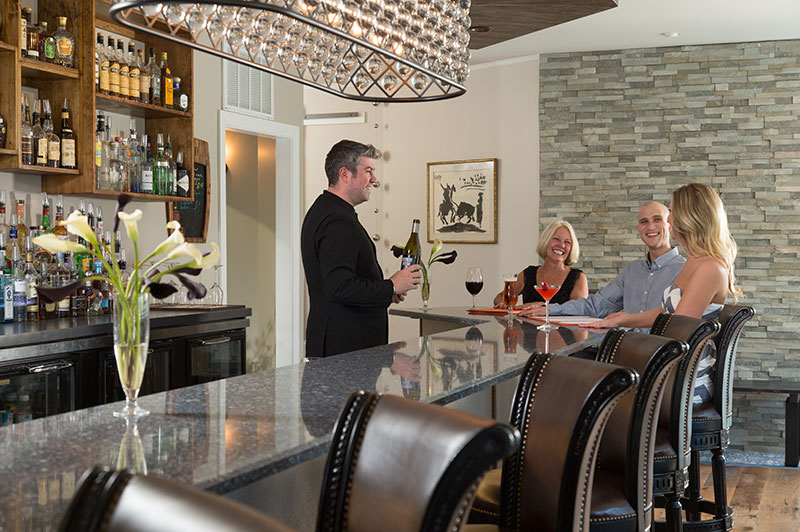
Christian Sorel serves up cocktails for happy customers
Finally, a light at the end of the tunnel in the form of a welcoming, pastoral bed and breakfast. We sprinted through the rain. Inside, a warm, effusive glow spread through the room, along the bar, weaving between eager diners holding their Champagne flutes and bantering in a low murmur as though there wasn’t a rainstorm of near-biblical proportions outside. We were greeted with two glasses of Trump Winery’s 2012 Blanc de Blanc. Sparkling, effervescent, with notes of green apple, lemon, pear, and a hard-to-place mineral component. Though not a Champagne, on account of the wine being manufactured in Charlottesville and not France, the effect was the same: buoyant, tingly, and the perfect blend of formality and fun. Then came the wine’s complement, a Canadian Raspberry Point oyster garnished with pomegranate and apple and a hint of cranberry. The briny slickness of the oyster balanced evenly with the tart pucker of the cranberry and the splintering crunch of a single pungent pomegranate seed. The combination was potent and reminded me, strangely, of a well-told story in that the conclusion is at once surprising and inevitable. Such a bold and balanced amuse bouche bode well for the six courses to come out of the kitchen of chefs Wright and Whitaker.
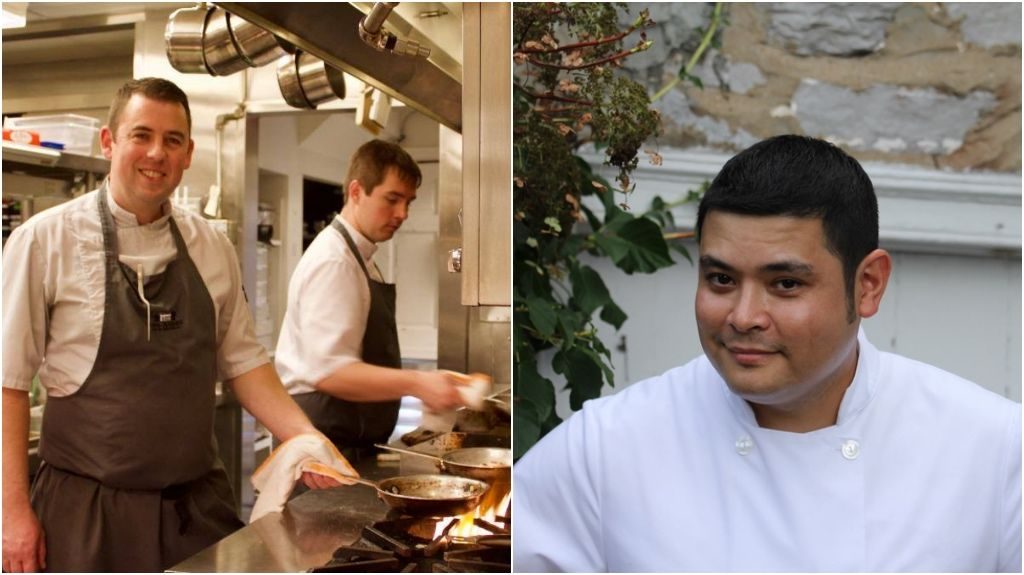
Chef Tom Whitaker (far left) of the Ashby Inn and Chef Richard Wright of L’Auberge Provencale teamed up for the Hunt Country Four Hands Dinner.
So who are these leading culinary figures of Virginia? The Ashby Inn and Restaurant’s Tom Whitaker hails from Hexham, in the north of England. “There’s no greater thing in life than the love of food,” he said. “It can evoke memories from childhood dinners, pub lunches with the family, comfort you in times of distress, and elevate enjoyment in times of happiness.” This curative, almost nostalgic approach to food is evident in his cuisine. There’s a warmth, a heartiness, a feeling of having eaten this before, but never quite like this.
Then there’s Chef Richard Wright. Born in the Philippines, Wright graduated from culinary school and cut his teeth on New York’s Le Bernadin, owned by three-Michelin Star chef Eric Ripert, for five years. “I’d like to take the philosophy of the owners along with my own and elevate our food and give it a modern approach,” Wright said of L’Auberge Provencale in an interview with Huffington Post. “To me, it’s also important to include even more local and sustainable cuisine. We already use ingredients from our own garden and local farms, but I’d like to do even more of that.” His intensely seasonal, as-local-as-possible approach manifests itself delightfully in his dishes.
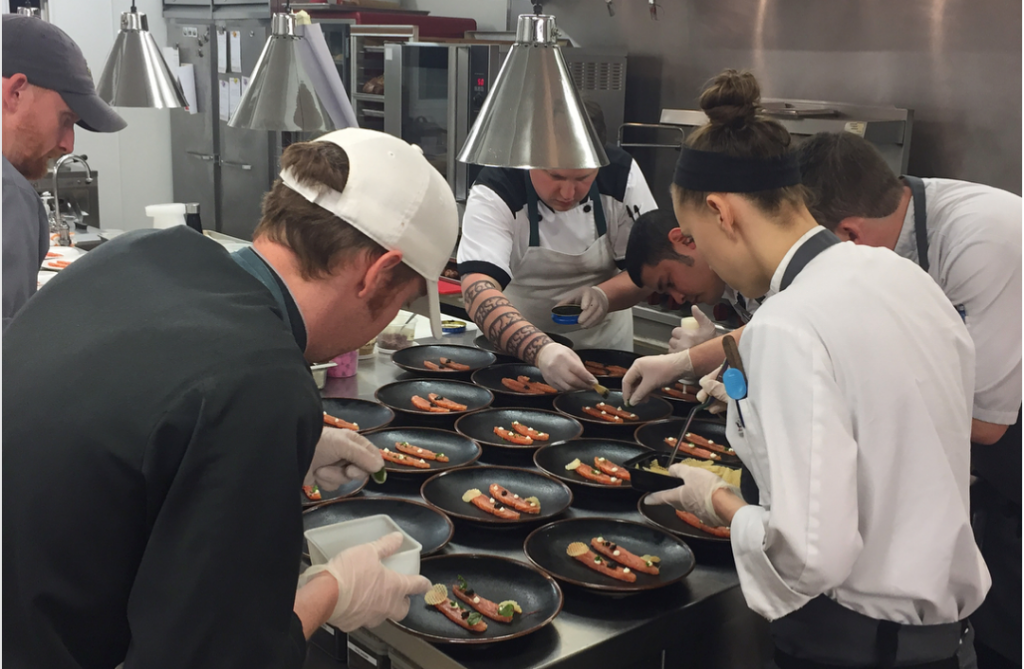
A talented culinary team puts the finishing touches on the second course
Tensions often run high in kitchens. When two master-craftsmen are crammed into the same cramped, sweltering kitchen for hours on end, one could expect there to be at least a little bickering, if not a full-on Gordon Ramsay meltdown. Especially when those two chefs are from nearby restaurants in something like a crosstown rivalry. I’m happy to report there was none of that. No Montague-Capulet feud, no simmering Hatfield-McCoy conflict. Merely by tasting their dishes, by admiring the harmony of their composition and presentation, I could tell that there was a spirit of collaboration, of teamwork, of mutual inspiration.
I guess I should tell you about the dinner then, huh? I’m delaying a little. On the one hand, I’m apprehensive: pictures won’t do it justice, neither will my words. On the other hand, I went into this dinner with high expectations and no idea what was on the menu. So isn’t it fair that I try to make your mouth water a little bit while building some suspense?
Okay, I’ll stop now.
Oh wait, one more thing. If after reading this and seeing these scrumptious pictures you feel a little regret, a sense of having missed out on an epicurean extravaganza, (F.O.M.O for my millennial readers) then be sure to reserve your seat at the table for the next Hunt Country Four Hands Dinner at Ashby Inn & Restaurant on April 20th.
Without further ado, the menu!
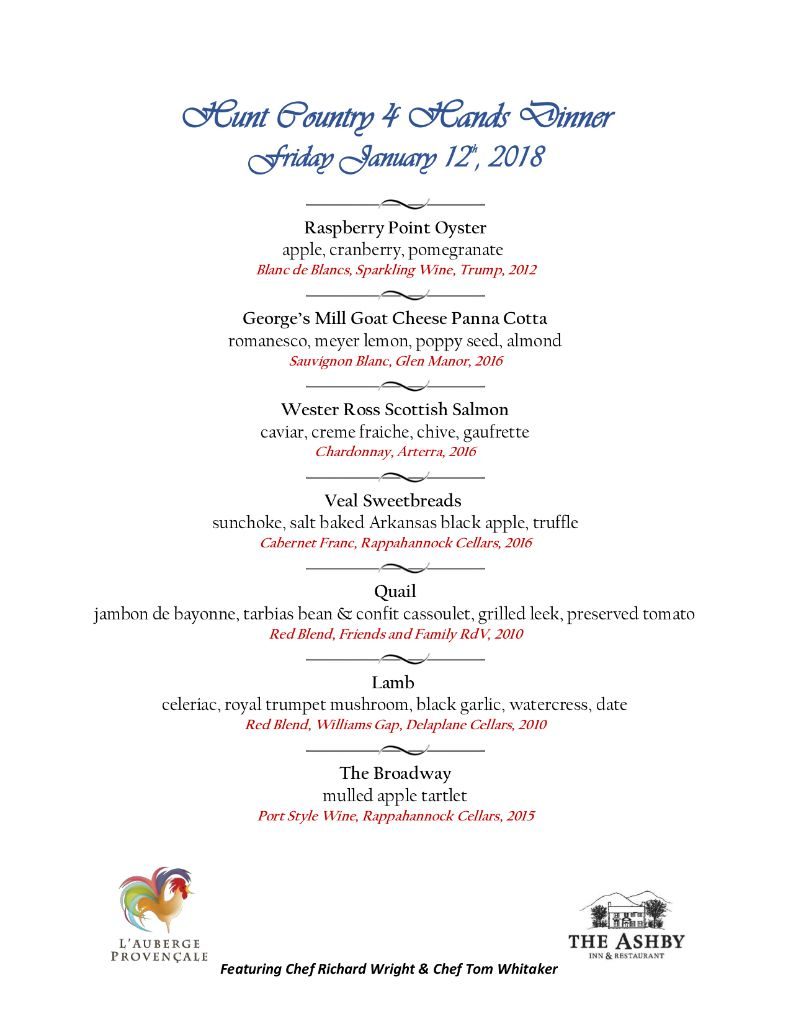
This is important. I mean, picture yourself seated at a table—pristine white tablecloth, low ambient lighting, a glass of sparkling wine and an empty plate, and this secret menu right there before you. Your imagination runs wild. Quail and duck? Veal sweetbreads? And what exactly is “The Broadway”? Your mind races as you try to envision the possibilities, the combinations.
Then the food arrives. And it’s prettier and tastier than you could’ve ever imagined. So let’s get to the food, what say you?
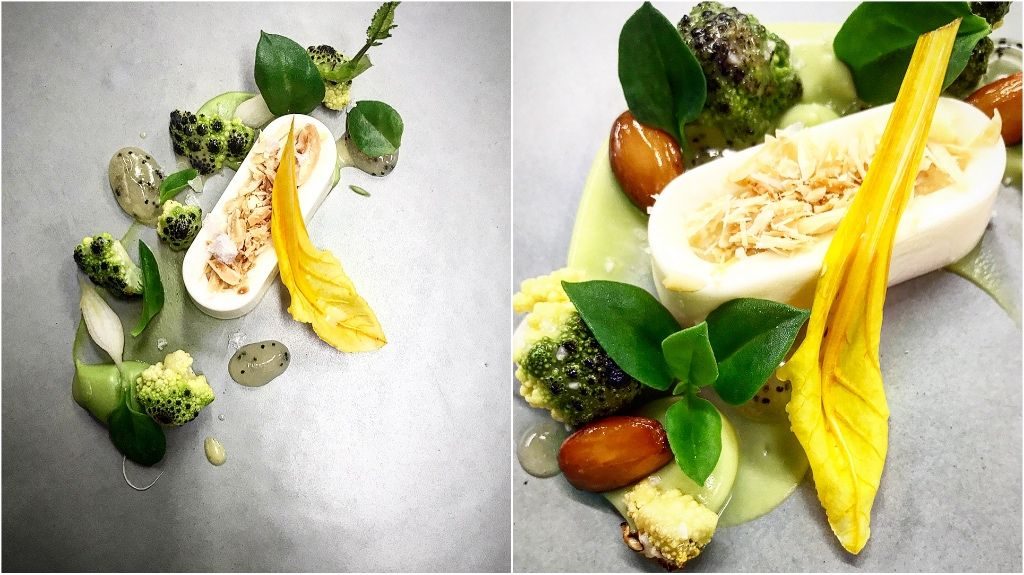
Up first was George’s Mill goat cheese panna cotta with Romanesco broccoli, Meyer lemon, poppy seed, and almond. The goat cheese was mild, subtle, and as creamy as a lightly poached egg at a Sunday-morning brunch. The baby broccoli was crunchy and earthy, fractal and magnificent. The almond added a smoky component, while the lemon cut through with its sour palette and the poppyseed added that missing piece of the puzzle. Then add to the mix the 2016 Sauvignon Blanc from Glen Manor Vineyards in Front Royal. “Such a pure expression of Sauv Blanc,” said Christian Borel, sommelier. “A dry, crisp, vibrant wine with minimal manipulation. Hope you all enjoy!”
Not only is Christian an expert, discerning wine aficionado, but also the son of L’Auberge Provencale founders Chef Alain Borel and innkeeper Celeste. Alain is a fourth-generation chef, certified pilot, and one of Discovery Channel’s “Great Chefs of the East.” The two founded the restaurant/bed and breakfast in 1981, and together built it into the cherished destination it is today. Alain, who retired in 2013, and Celeste were seated at the table opposite mine, and I can truthfully report that they were smiling ear-to-ear at every dish that came out of the kitchen and every glass of wine introduced by their son.
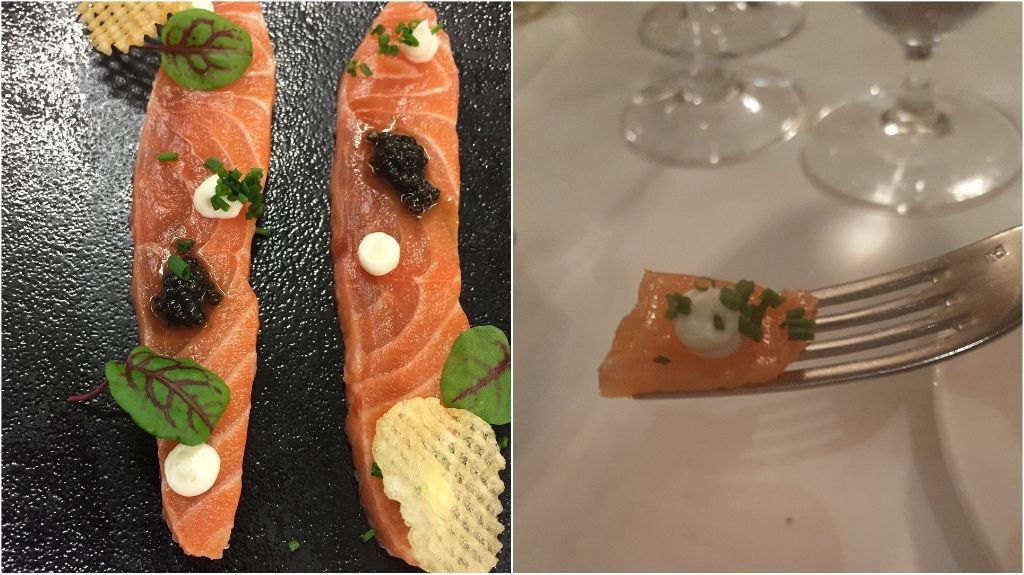
The second course was a Wester Ross Scottish salmon with caviar, crème fraîche, chive, and a gaufrette (a.k.a Neapolitan wafer; it’s always fun to learn a new word at these dinners!). Two thin, gorgeous strips of succulent salmon with caviar that burst with flavor and the crème fraîche (somewhere between a pinch and a dollop: the perfect amount so as not to overwhelm, but rather accentuate each bite) together created a silken combination of rich and salty flavors that were punctured by the chives and playfully interrupted by the snap of the wafer. The dish was paired with a Chardonnay from Arterra Wines in Delaplane. Christian described it precisely: “This 2016 has the fattiness of a vintage that is often mistaken for ‘oakiness,’ but is actually quite light on the oak.” I’ll concede: I’m far from a oenophile, but I love when a word and a sense—image, sound, or in this case, taste—align. Christian’s knowledge of wines, his carefully calibrated tastebuds, are matched by his poetic descriptions.
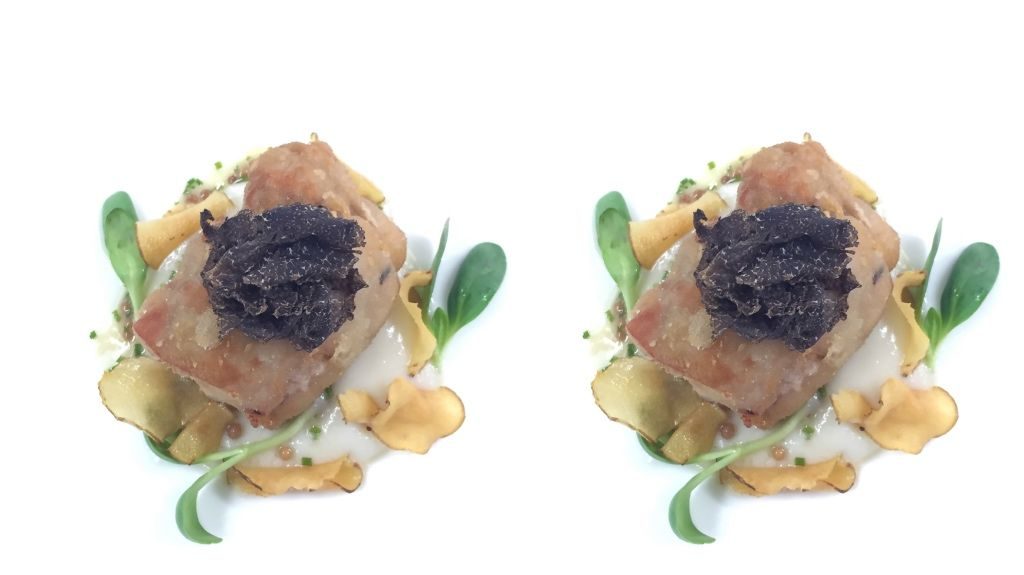
Sweetbreads are divisive. The texture is off-putting to many, the metallic flavors offensive. And that’s to say nothing of what sweetbreads actually are (Hint: neither “sweet” nor “bread”). I for one love them. Especially when they’re paired with sunchoke (or Jerusalem artichoke), salt-baked Arkansas black apple, and truffle. In fact, this was my personal favorite. As much as the balanced textures and flavors, I loved that the two chefs were willing to take a risk. The dish had such a rich, sanguine flavor that was buttressed by the saltiness of crisp apple. The tenderness was unsurpassed. The dish was complemented by the evening’s first red wine: Rappahannock Cellars’ 2016 Cabernet Franc. Vintner Theo Smith introduced the wine, which he described as “a fruit-forward blend of two different wines, one from Shenandoah County, the other from Rappahannock.” Smith was a crowd favorite. A knowledgeable storyteller with wit and no shortage of jokes, we could’ve listened to him describe the life of a winemaker for hours if we weren’t so eagerly anticipating the next course: quail with Jambon de Bayonne, tarbias bean and confit cassoulet, grilled leek garnish, and preserved tomato.
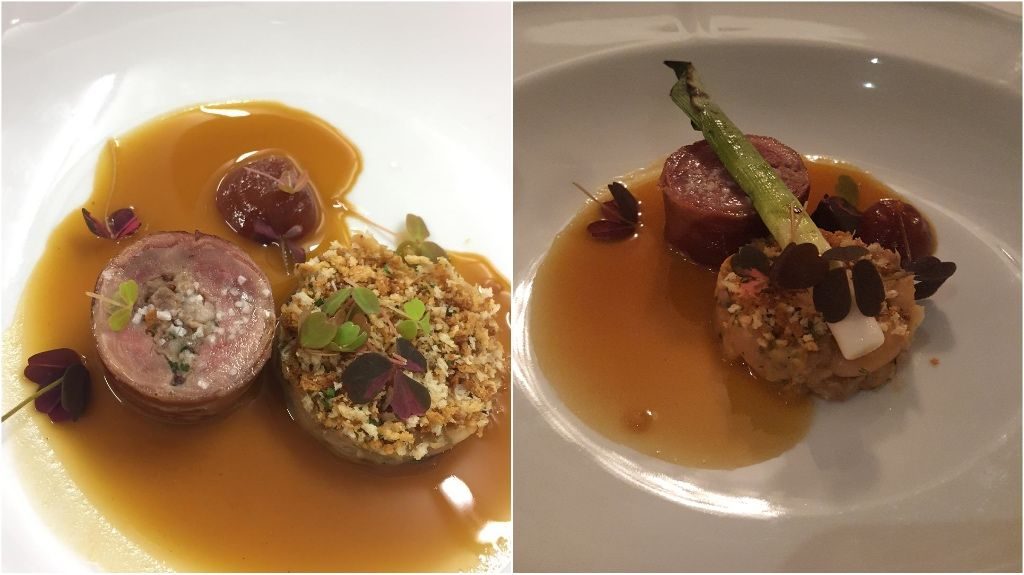
That’s a mouthful. Pun intended. Well, not really, but it’s there and I’m leaving it. Grilled leek might be the biggest takeaway from this evening, for me anyway. Young, spindly, tender, this flavorful garnish accentuated the meatiness of the quail and duck. The tomato sauce intermingled with the juices of the two birds to produce a sweet and savory alloy that would delight umami lovers. The presentation encapsulated the flavors in a bizarre, incredible synesthesia. The two circles—one quail, one duck—were joined as it were by the grilled leek I was just raving about. The charred onion taste bridged the two poultry elements. A “high-end Bordeaux,” as Smith described it, enriched the trinity of taste. A 2010 blend from RdV was “eccentric” and “concentrated the dark fruit” notes.
What was next? Our expectations had been raised, exceeded, and raised again after every course. Our stomachs were getting full. Our cheeks were rosied by wine. Our table-mates were now our friends. How could it get any better? In a word: lamb.
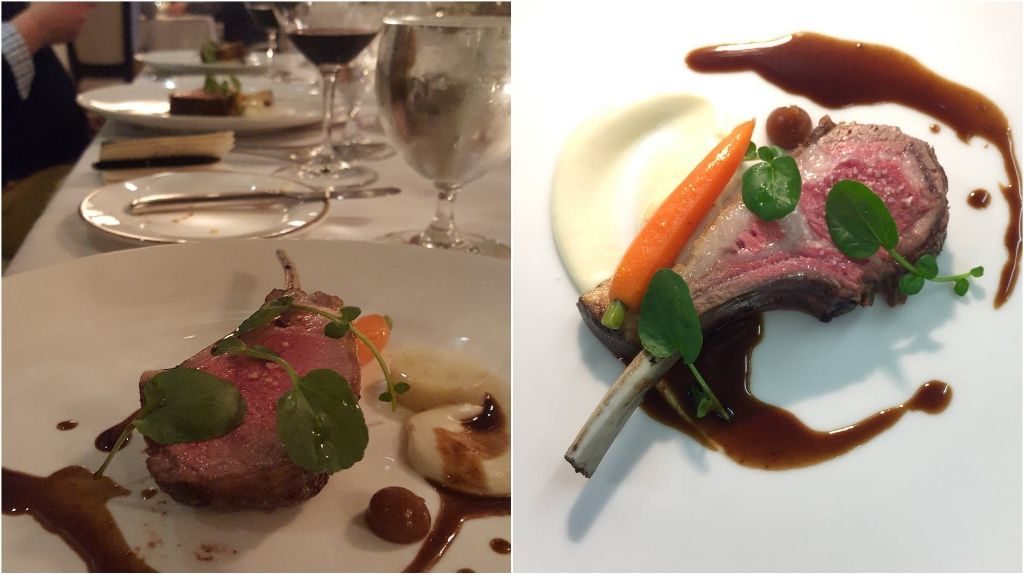
Or, more specifically, lamb with with celeriac, royal trumpet mushroom, black garlic, watercress, and date. In keeping with both chefs’ dedication to seasonal vegetables, the wintry celeriac was wonderfully hearty, nutty, and sweet. This versatile vegetable offered different tastes with each bite, an astounding example of culinary magic that would leave a wizened diner scratching their heads. Aided by the sharp, mustardy, arugula-on-steroids peppery-ness of the watercress and the syrupy, caramelized black garlic, the dish was unlike any that I’ve ever had before and ever will again (unless I get really lucky). Delaplane Cellars, a neighbor of RdV, provided a red blend, Williams Gap, from 2010. Comparing and contrasting this with RdV’s blend was the highlight of the night as far as wines go. To reiterate: I’m not an experienced wine buff. I can barely pronounce terroir, much less define it or, God forbid, give you an example of it. But comparing two wines from the same year, grown from grapes in the same county, proved to be a delightful game. Whereas RdV’s was “eccentric,” Delaplane’s was lush. Both equally fruit-forward, both equally divine and well-paired with the different dishes. Surely such a comparative tasting was planned by the sommelier, and added yet another wonderful component to what was shaping up to be a memorable evening of incredible food, wine, and conversation.
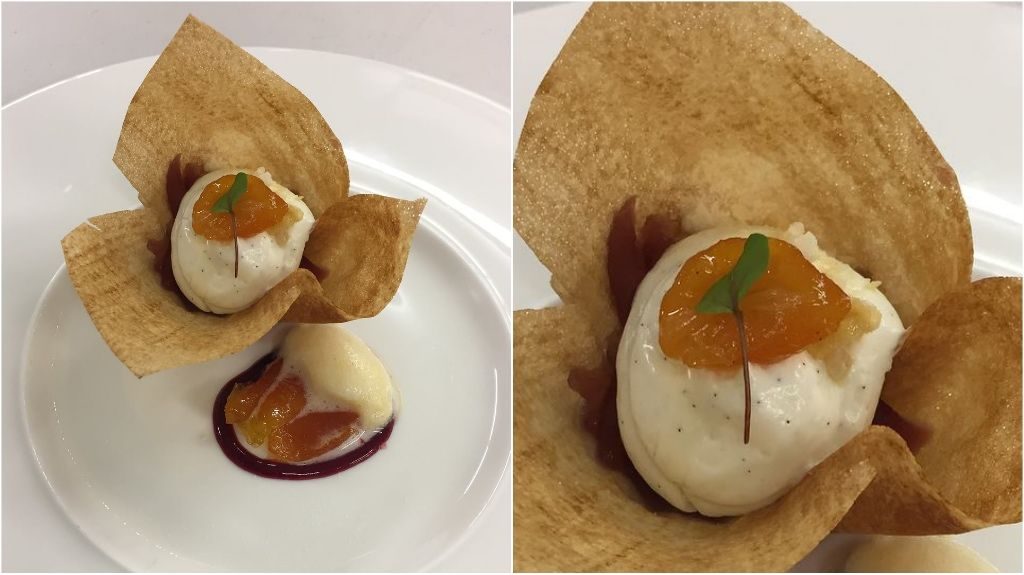
And then they brought out the “Port,” which I put in quotes only to delineate the Virginia-grown, 100% Norton wine from the eponymous Portuguese dessert wine. The Rappahannock Cellars’ wine from 2015 was a great capstone on a fantastic evening. More of a digestif than dessert, the “Port-style” wine tickled the tastebuds with vanilla, coconut, and cocoa aromas. The 42 proof wine cleansed our palettes with waves of rich, tannic notes and readied us for the final course: the enigmatically titled “Broadway.”
What’s left to say? Do you harbor any suspicions that this course was any less magnificent than its predecessors? I hope not. The mulled apple tartlet was charged with candied bits of fruit. The warmth of the pastry and the cold tang of vanilla ice cream melded together and accentuated the complexity of the wine. The edible pastry was reminiscent of a fortune cookie, and I felt fortunate indeed. Fortunate to have been a guest, fortunate to have chefs such as Tom and Richard who work together to provide diners with an unforgettable experience, and fortunate to be writing this review, fortunate to have a platform to share it with you, and grateful to you all for reading. Merci beaucoup; I’ll see you at the Ashby Inn & Restaurant in April. Of that I’m sure.
I always enjoy reading your articles. Love this publication!
Textural contrasts also were hugely appealing with the sweetbread katsu ($10).